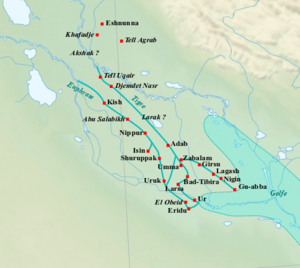Abu Salabikh facts for kids
| [[File::None at this time|frameless]] | |
| Location | Al-Qādisiyyah Governorate, Iraq |
|---|---|
| Region | Mesopotamia |
| Coordinates | 32°16′00″N 45°05′00″E / 32.26667°N 45.08333°E |
| Type | Settlement |
| History | |
| Founded | Early Uruk period |
| Site notes | |
| Excavation dates | 1963-65, 1975–90 |
| Archaeologists | Donald P. Hansen, Nicholas Postgate |
Abu Salabikh is an ancient city site in Iraq. It's about 150 kilometers (93 miles) southeast of modern Baghdad. This small Sumerian city existed for a very long time. It was important from the Stone Age (Neolithic period) until the late 2000s BC. The city had connections with other big cities like Kish, Mari, and Ebla. We don't know its original name for sure. Some people think it might have been Eresh or Kesh.
The Euphrates River was like the city's main road and life source. When the river changed its path, the city slowly faded away. Today, only old traces of the city remain on the surface.
Contents
A Glimpse into Abu Salabikh's Past
People lived at Abu Salabikh even in the Stone Age. But the city was most active during later periods. These include the Uruk, Jemdat Nasr, and Early Dynastic periods. These times were part of the Early Bronze Age.
There were also signs of people living in the area during later times. These include the Kassite, Sassanian, Seleucid, and Parthian periods.
Exploring the Ancient City
The site of Abu Salabikh has three main mounds, or hills. These mounds cover an area of about 900 by 850 meters. The largest is the Main Mound, which was surrounded by a wall. It covers about 12 hectares (about 30 acres).
To the west, there's another large mound. This one was home to the Uruk and Jemdet Nasr periods. South of that is the South Mound, where an Early Dynastic palace was found.
Who Dug Here?
American archaeologists from the Oriental Institute of Chicago first dug at Abu Salabikh. Donald P. Hansen led these digs in 1963 and 1965. They found that the site was in a salty marsh. Unlike nearby cities, Abu Salabikh's ancient remains were close to the surface.
The American team found about 500 clay tablets and pieces of tablets. These tablets contained some of the earliest known ancient writings. They also found animal bones, including dogs, lions, pigs, and sheep.
Later, a British team took over the excavations. This was from 1975 to 1990. Nicholas Postgate led this team. Their work stopped in 1990 and has not started again.
Amazing Discoveries: Cuneiform Tablets
The city of Abu Salabikh was built in a planned way during the early Uruk period. The British team found about 500 more cuneiform tablets. Cuneiform is one of the earliest forms of writing. These tablets are now kept in the Iraq Museum in Baghdad.
The tablets are similar to others found in a city called Shuruppak. They include:
- School texts, which helped people learn to write.
- Literary texts, like stories and poems.
- Word lists, which were like ancient dictionaries.
- Administrative records, showing how the city was run.
One very important text found was the Instructions of Shuruppak. This is a famous Sumerian "wisdom" text. The tablet from Abu Salabikh is the oldest copy of this text ever found!
Even though the writing was Sumerian, many scribes (writers) had Semitic names. This became more common over time. The ancient Sumerian language in these texts is still being studied. Some literary works found were thought to be much newer. But the Abu Salabikh tablets showed they were actually very old.
Other Interesting Finds
On the Uruk mound, archaeologists found 1650 clay sickles. These were tools used for harvesting crops. They also found 74 Neolithic clay accounting tokens. These were small clay shapes used for counting and keeping track of goods.
More than 100 pottery pieces were also found. These were shaped into small discs and had holes in them. Experts think they might have been used in early counting devices, like an abacus.
Eresh: A Nearby Ancient City?
The ancient city of Eresh is known from many old texts. Its exact location is still a mystery. Some people think Abu Salabikh might be the site of Eresh. One tablet found at Abu Salabikh mentioned workers belonging to a "King of Eresh."
The main goddess of Eresh was Nisaba. She was the goddess of writing and wisdom. Later, her place of worship moved to Nippur.
Enheduanna, who was the daughter of Sargon of Akkad, wrote many hymns. Sargon was the first ruler of the Akkadian Empire. One of Enheduanna's hymns was about E-Zagin, which was Nisaba's temple in Eresh.
The hymn describes the temple as a "House of Stars" and "House of Lapis Lazuli." It praises Nisaba as a wise goddess. She is described as "giving guidance to all the lands" and "measuring the heavens."
In an old Sumerian story, a sorcerer goes to Eresh. He makes all the cows and goats stop giving milk. This shows that Eresh was a known place in ancient stories.
See also



